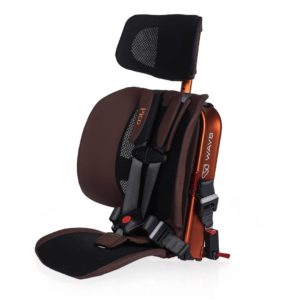Most clichés about children are right on: They grow so fast! You blink your eyes, and they’re gone! Treasure every moment!
Parents are so proud when a child reaches a milestone—his first smile, her first tooth, his first day of daycare; however, some milestones, such as switching to a front-facing car seat, should not be rushed.
It’s scary, but it’s a reality: car accidents happen daily. However, according to the National Highway Traffic Safety Administration, child and infant car seats significantly reduce the risks of fatal injury in infants and toddlers in the event of a crash.

Children are safest when they are riding in a rear-facing car seat, and they should stay there as long as possible. In 2018, the American Academy of Pediatrics (AAP) released an important new policy on this issue.
Previously, the AAP specified that children should remain in rear-facing car seat until age two. However, the new guidelines remove the age-specific mark and instead state that children stay in a rear-facing car seat for “as long as possible, until they reach the highest weight or height allowed by their car safety seat’s manufacturer.”
Since this recommendation removes the age constraints, this means that other factors need to be considered before making this switch. It is crucial not to rush this decision though since keeping a child in a rear-facing car seat is the best safety practice.
Why Should You Keep your Child in a Rear-Facing Seat for as Long as Possible?
Keeping your child in the rear-facing seat for as long as possible ensures they are as safe as possible.
Here are a few reasons why rear-facing seats excel in safety:
- Young children are more at risk for head and spinal cord injuries because their bones and ligaments are still developing. Because of this, their heads are typically larger than their necks, which means they need extra support. Rear-facing car seats give the best support to a child’s head, neck, and spine.
- If you are in a front-end accident (which is the most common type of accident), a rear-facing car seat allows your child’s head, neck, and spine to move evenly into the seat, not away from it, which could cause damage.
- Rear-facing car seats are also better at protecting a child’s arms and legs. Ben Hoffman, a nationally recognized injury prevention specialist and pediatrician at the Doernbecher Children’s Hospital, Oregon Health & Science University explains, “In a forward-facing car seat during an accident, your child’s arms and legs fly forward and are more likely to be injured. In a rear-facing car seat, the chance of injuries to the arms and legs in a crash is less than 1 in 10,000.”
It is also interesting to note that children in Sweden are required to stay in a rear-facing car seat until they are four years old. The child death rate from automobile accidents in Sweden is nearly zero!
Factors to Consider When Switching Your Child to a Front Facing Car Seat

A Child’s Height
Parents should abide by the height that the rear-facing car seat recommends. Typically, the height limit for most rear-facing car seats is to allow at least one inch of room between the top of the child’s head and the top of the car seat.
This inch of room will ensure that if the child slides up in the seat during a car accident, his or her head will stay protected.
A Child’s Weight
Another factor parents should consider when making the switch to front-facing is the child’s weight. Most convertible car seats allow the child to sit rear-facing for up to 40-50 pounds.
Again, check the rear-facing car seat’s manual.
Types of Forward-Facing Car Seat Restraints
When you are looking to transition to a forward-facing car seat, you can explore these options and choose the best one for your child and situation:
Forward Facing Car Seat
The forward-facing car seat is suitable for children up to 80 lbs. This type is your typical car seat, complete with a harness and tether.
We covered front facing car seat extensively in our best forward facing car seat guide.
Convertible Seats
Convertible seats are convenient because they can convert from rear-facing to forward-facing and then to a booster seat. If you buy a convertible seat, you will not need to invest in any other car seat.
Combination Car Seat
The combination car seat is a forward-facing only seat. When the child reaches the maximum height or weight for the seat, the 5-point harness straps can be detached, and the seat converts to a booster seat.
All-in-One Car Seat
This seat can change from a rear-facing seat to a forward-facing seat (with a harness and tether) and then to a booster seat.
Both the convertible car seat and the all-in-one car seat can be used rear-facing until the child reaches the maximum height or weight. Both seats can then be converted to forward-facing seats.
The forward-facing car seat is the only one that will not transition to a booster seat.
Correct Installation
When installing a car seat, it is vital that you read the instructions carefully. Each car seat differs slightly in its design and mechanics, so make sure you understand yours.
Always install your car seat in the back seat of your car, as this is the safest place for your child to ride. Always make sure to lock the seat belt into place around the seat and secure it tightly so it cannot wiggle back and forth. Finally, connect the tether strap, which is an extra safety measure and will prevent head movement in the event of an accident.
If you need help installing your car seat or have questions regarding your car seat, you can easily find a certified child passenger safety technician (CPST) to help you. Lists of certified CPSTs, along with child seat–fitting stations are available on the following Web sites:
- NHTSA Parents & Caregivers
- National Child Passenger Safety Certification (Click on “Find a Tech” or call 877/366-8154.) – This website also includes a list of CPSTs who are fluent in Spanish and other languages or with extra training in the transportation of children with special needs.
Sources:
“AAP Updates Recommendations on Car Seats for Children.” AAP.org, www.aap.org/en-us/about-the-aap/aap-press-room/Pages/AAP-Updates-Recommendations-on-Car-Seats-for-Children.aspx.
BabyCenter. “How Long to Keep Your Child in a Rear-Facing Car Seat.” BabyCenter, www.babycenter.com/0_how-long-to-keep-your-child-in-a-rear-facing-car-seat_10348811.bc.
“How to Install a Child Safety Seat.” DMV.ORG, www.dmv.org/how-to-guides/install-child-seat.php.
The Car Crash Detective, www.thecarcrashdetective.com/a-guide-to-swedish-child-car-seat-safety-for-americans/.
Related Articles:




